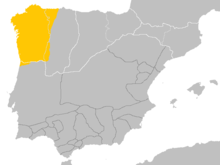Medieval Galician
| Galician-Portuguese | |
|---|---|
| Native to | Kingdom of Galicia, County of Portugal |
| Region | North-west Iberia |
| Era | Attested 870 A.D.; by 1400 had split into Galician, Fala, and Portuguese. |
|
Indo-European
|
|
| Language codes | |
| ISO 639-3 | – |
|
Linguist list
|
079 |
| Glottolog | None |
 |
|
Galician-Portuguese (Galician: galego-portugués or galaico-portugués, Portuguese: galego-português or galaico-português), also known as Old Portuguese or Medieval Galician, was a West Iberian Romance language spoken in the Middle Ages, in the northwest area of the Iberian Peninsula. Alternatively, it can be considered a historical period of the Galician and Portuguese languages.
Galician-Portuguese was first spoken in the area bounded in the north and west by the Atlantic Ocean, and by the Douro River in the south, comprising Galicia and northern Portugal, but it was later extended south of the Douro by the Reconquista.
It is the common ancestor of modern Portuguese, Galician, Eonavian and Fala varieties. The term "Galician-Portuguese" also designates the subdivision of the modern West Iberian group of Romance languages.
Galician-Portuguese developed in the region of the former Roman province of Gallaecia, from the Vulgar Latin (common Latin) that had been introduced by Roman soldiers, colonists and magistrates during the time of the Roman Empire. Although the process may have been slower than in other regions, the centuries of contact with Vulgar Latin, after a period of bilingualism, completely extinguished the native languages, leading to the evolution of a new variety of Latin with a few Gallaecian features.
Gallaecian and Lusitanian influences were absorbed into the local Vulgar Latin dialect, which can be detected in some Galician-Portuguese words as well as in placenames of Celtic and Iberian origin like Bolso. In general, the more cultivated variety of Latin spoken by the Hispano-Roman elites in Roman Hispania had a peculiar regional accent, referred to as Hispano ore and agrestius pronuntians. The more cultivated variety of Latin coexisted with the popular variety. It is assumed that the Pre-Roman languages spoken by the native people, each used in a different region of Roman Hispania, contributed to the development of several different dialects of Vulgar Latin and that these diverged increasingly over time, eventually evolving into the early Romance Languages of the Iberia.
...
Wikipedia
